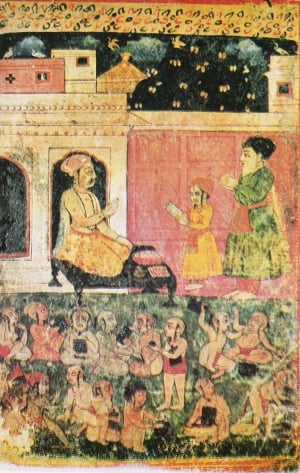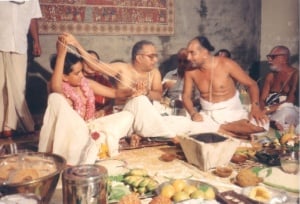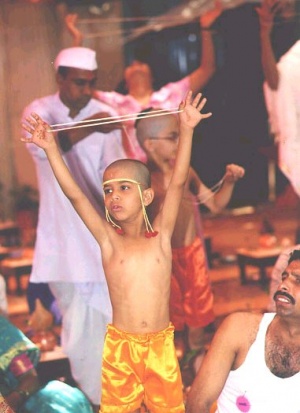Guru Nanak and the Sacred Thread

When Nanak had attained the age of nine years, his father determined to have him invested with the Janoy or janeu, or sacrificial thread of the Hindus. Until a boy is so invested, he is deemed almost an outcast. When the members and relations of the family, and all the neighbours, secular and religious, had assembled, and all preliminary rites had been duly performed, Hardial, the family priest, proceeded to put the sacred thread on Nanak's neck. The boy caught the thread with his hand, and asked the priest what he was doing, and what advantage it was to put a thread of that description on him. The priest then explained that the janoy was the basis of the Hindu religion, that without it a man would only be a Sudar (their are four great varans or castes of Hinduism: Brahmans, the priestly class; Kshatris, the militant class; Vaisyas, the trading class; and Sudars, the working class and lowest of all. Of these castes their are now many subdivisions), and that by putting it on greatness should be obtained in this world and happiness in the next. On hearing this the young Guru gave utterance to the following:
From Asa ki Var:
| Make mercy thy cotton, contentment thy thread, continence its knot, truth its twist. That would make a janoy for the soul; if thou have it, O Brahman, then put it on me. It will not break, or become soiled, or be burned, or lost. Blest the man, O Nanak, who goeth with such a thread on his neck. Thou purchasest a janeu for four damris, and seated in a square puttest it on; Thou whisperest instruction that the Brahman is the guru of the Hindus-- Man dieth, the janeu falleth, and the soul departeth without it. |
The priest explained that the custom of wearing a janoy had descended from the Vedic ritual, and that no Hindu could be deemed religious without wearing it. The Brahman then familiarly addressed the Guru, Thou art but a child of yesterday, and are we not as wise as thou? Unless thou wear this thread thou shalt be deemed a person without religion. Guru Nanak replied:
| Though men commit countless thefts, countless adulteries, utter countless falsehoods and countless words of abuse; Though they commit countless robberies and villanies night and day against their fellow creatures; Yet the cotton thread is spun, and the Brahman cometh to twist it. For the ceremony they kill a goat and cook and eat it, and everybody then saith 'Put on the janeu'. When it becometh old, it is thrown away, and another is put on, Nanak, the string breaketh not if it be strong. |
The Brahman priest, on hearing this, became angry, and asked the Guru if everybody else was a fool, and he alone, who had abandoned the customs of his forefathers, was wise. He then called on the Guru to tell him what a proper janoy was. The Guru replied:
| By adoring and praising the Name honour and a true thread are obtained. In this way a sacred thread shall be put on, which will not break, and which will be fit for entrance into God's court. |
The Guru then wound up his instruction on the subject as follows:
| There is no string for the sexual organs, there is no string for women; There is no string for the impure acts which cause your beards to be daily spat upon; |
Background info on Upanayanam (Thread Ceremony)
Upanayanam is the Samskara or the ceremonial rite in which the young Brahmin boy is invested with the sacred thread and initiated into the Gayatri - the Holiest of all mantras in the legacy of the Rishis. This ceremony is only for boys from the top three social classes. Traditionally, an auspicious time and date is chosen to shave the boy's head completely, leaving only a small tuft in the centre of the scalp, called bodi.
The sacred thread used for the ceremony consists of three strands, joined by a knot known as Brahmagranthi or the knot of Brahma. The three strands symbolise the Hindu trinity - Shiva, Vishnu and Brahma. There are various interpretations of the three strands to represent many of the other triads like Mahasarasvati, Mahalakshmi and Mahakali. Or the three qualities known as sattva, rajas and tamas; past, present and the future; the three states - wakefulness, dream and deep sleep. Some even say that it represents the three dimensions known as heaven (swarga), earth (martyaloka) and nether regions (patala). The twist of the thread must be upwards to ensure that the Sattwaguna or the good quality of truth predominates.
But the most important meaning of the three strands is ida, pingala and susumna nadi, through which the kundalini energy manifests as prana and consciousness. Yajno-pavita means 'thread of sacrifice.' That is so called because it symbolises the sacrifice of ego.
The sacred thread is a passport to obtain education. It is a prerequisite for education and also for marriage. For without it no man can dream of getting a bride for him. It was considered important because a person with Yajnopavita must have undergone all the oaths associated with wearing it and should have led a celibate life and should have completed a major portion of his education. Brahmachari or the bachelor (also, a learner) wears a single sacred thread. The householder or the married person wears two. A person who is married and has lost one or both of his parents wears three.
There are different methods of wearing the Sacred Thread at different occasions. While performing an auspicious ceremony one should be Upaviti, that is, the Sacred Thread should hang from his left shoulder. At the performance of some inauspicious ceremony one should be Prachnaviti, that is, the Sacred Thread should hang from the right shoulder; and at times he is called Niviti when the Sacred Thread is worn round the neck like a garland.
Quotes
The sacred thread ceremony marks the passage to maturity for boys of the upper three castes. This initiation (upanayana) takes place between the ages of six and twelve to mark the transition to greater religious awareness and responsibility. At the ceremony itself, the family priest invests the boy with a sacred thread to be worn always over the left shoulder, and the parents instruct him in reciting the Gayatri Mantra*. The initiation ceremony is seen as a new birth; those groups entitled to wear the sacred thread are called the twice-born.from sln.org.uk
See also
- The Hindu Sacred Thread, Janeu
- Guru Nanak
- Sati
- Sikhism and Ritualism
- Raksha Bandhan
- Guardian of human rights
- Why did Guru Nanak reject the Janoy
- Evaluating Dayanand's Views on Guru Nanak & the Sikhs
- Var Haqiqat Rai
References
- Macauliffe, M.A (1909). The Sikh Religion: Its Gurus Sacred Writings and Authors. Low Price Publications. ISBN 8175361328.
- (XXXX). B-40 Janamsakhi - Guru Baba Nanak Paintings. Guru Nanak Dev University. ISBN 8177700111.


